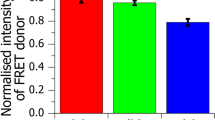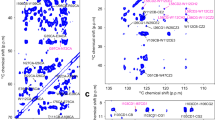Abstract
THE most convincing studies of molecular order in model membranes are undoubtedly those involving deuterium nuclear magnetic resonance (NMR) of labelled lipids in the lamellar liquid crystalline phase1–6. The relevance of these results to biological membranes has not yet been established, however; there is no a priori reason to expect the state of organisation of lipids in the lamellar liquid crystal to resemble closely that of a natural membrane. We report here the first detailed study of acyl chain order in the lipids of a natural biological membrane—the plasma membrane of the microorganism Acholeplasma laidlawii. Specifically deuterated fatty acids were incorporated biosynthetically into the membrane lipids as described previously7. The 2H-NMR spectra of the membrane demonstrate the co-existence of at least two different kinds of lipid. Signals from the more fluid lipid are most prominent at temperatures near and above the growth temperature (37 °C). The more solid-like lipid, which predominates at lower temperatures, may be similar to the gel state of lamellar phases and could include lipid associated with the membrane protein. For the more fluid phase, the plot of order parameter against position of deuteration strongly resembles that for egg yolk2 and dipalmitoyl3 phosphatidylcholine. Incorporation of cholesterol into the membrane of A. laidlawii increases the average acyl chain order and also increases the spread of order parameters, similar to its effect on egg yolk phosphatidylcholine6. These results represent a major justification for the use of lamellar liquid crystals as models for the lipid in biological membranes.
This is a preview of subscription content, access via your institution
Access options
Subscribe to this journal
Receive 51 print issues and online access
$199.00 per year
only $3.90 per issue
Buy this article
- Purchase on Springer Link
- Instant access to full article PDF
Prices may be subject to local taxes which are calculated during checkout
Similar content being viewed by others
References
Oldfield, E., Chapman, D. & Derbyshire, W. FEBS Lett. 16, 102–104 (1971).
Stockton, G. W., Polnaszek, C. F., Tulloch, A. P., Hasan, F. & Smith, I. C. P. Biochemistry 15, 954–966 (1976).
Seelig, A. & Seelig, J. Biochemistry 13, 4839–4846 (1974).
Mely, B., Charvolin, J. & Keller, P. Chem. Phys. Lipids 15, 161–173 (1975).
Marcelja, S. J. chem. Phys. 60, 3599–3604 (1974).
Stockton, G. W. & Smith, I. C. P. Chem. Phys. Lipids 17, 251–263 (1976).
Stockton, G. W. et al. Biochim. biophys. Acta 401, 535–539 (1975).
Davis, J. H., Jeffrey, K. R., Bloom, M. & Valic, M. I. Chem. Phys. Lett. 42, 390–394(1976).
Steim, J. M., Tourtellotte, M. E., Reinert, J. C., McElhaney, R. N. & Rader, R. L. Proc. natn. Acad. Sci. U.S.A. 63, 104–109 (1969).
Seelig, A. & Seelig, J. Biochim. biophys. Acta 406, 1–5 (1975).
Davis, J. H., & Jeffrey, K. R. Chem. Phys. Lipids (in the press).
Author information
Authors and Affiliations
Rights and permissions
About this article
Cite this article
STOCKTON, G., JOHNSON, K., BUTLER, K. et al. Deuterium NMR study of lipid organisation in Acholeplasma laidlawii membranes. Nature 269, 267–268 (1977). https://doi.org/10.1038/269267a0
Received:
Accepted:
Issue Date:
DOI: https://doi.org/10.1038/269267a0
This article is cited by
-
Helical membrane protein conformations and their environment
European Biophysics Journal (2013)
-
High‐resolution nuclear magnetic resonance spectroscopy —Applications to fatty acids and triacylglycerols
Lipids (1997)
Comments
By submitting a comment you agree to abide by our Terms and Community Guidelines. If you find something abusive or that does not comply with our terms or guidelines please flag it as inappropriate.



